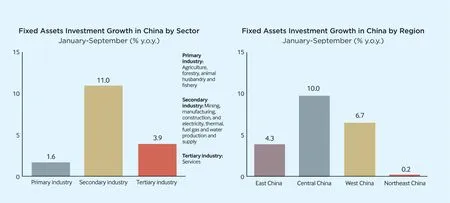THIS WEEK
2022-11-04
Autumn Beauty

Visitors enjoy the autumn scenery at Yuanmingyuan Park, or the Old Summer Palace, in Beijing on October 26.
Increased Flights
China’s civil aviation sector started the new winter and spring season on October 30, planning 104,573 passenger and freight flights every week, according to the Civil Aviation Administration of China.
The flights will be operated by 127 domestic and international airlines, and the season will last until March 25.
Fifty-four airlines will operate 95,173 flights per week domestically, excluding flights between Hong Kong, Macao and Taiwan,a year-on-year increase of 2.31 percent.
New air routes are being introduced by 37 airlines, operating 6,065 flights on 445 routes every week.
A total of 2,412 passenger and freight flights will operate every week between the Chinese mainland and Hong Kong,Macao and Taiwan, a year-onyear drop of 2.31 percent.
During the new season,more international flights will operate with 840 inbound and outbound flights per week, a year-on-year increase of 105.9 percent, Xu Qing, Deputy Director of the administration’s transport department, said at a news conference in Beijing on October 26.
Airlines have released their flight plans for the new season,resuming and increasing the number of international passenger flights.
The sector operated 1.08 million flights in the third quarter,a year-on-year decrease of 12.6 percent.
Finless Porpoise Named
China’s first artificially bred second generation finless porpoise was named Hanbao in Wuhan,Hubei Province, on October 24,which was Yangtze Finless Porpoise Protection Day and the International Day of Freshwater Porpoises.
Hanbao is a play on words that means little baby, or treasure, in Chinese and also indicates that the porpoise was born in Wuhan.
Hanbao was born on June 3,2020. His father Tao Tao, born on July 5, 2005, was the first finless porpoise in the world to have been successfully bred naturally in an artificial breeding environment.
The Yangtze finless porpoise is the only freshwater subspecies in the finless porpoise family.The International Union for Conservation of Nature lists the species as critically endangered.It is found only in parts of the middle and lower reaches of the Yangtze River. Nearly half the species’ population lives in Poyang Lake in Jiangxi.
Digital Protection
The digital protection project of the Mati Temple Grottoes in Zhangye City, Gansu Province,has been completed, local authorities said on October 25.
The project, launched last June with a total investment of 3.89 million yuan ($530,000),includes data collection for the surrounding environment of the grottoes, digital scanning of the murals and sculptures preserved in primary caves, and 3D reconstruction of cave structures.
As the grottoes were built on fragile red sandstone at an altitude of about 2,500 meters, the climatic conditions and rough terrain have brought about risks such as weathering and efflorescence (mineral deposits accumulating on rock faces) for the grottoes, despite undergoing many protective measures,according to the Zhangye Institute for Cultural Heritage Preservation.
First built around 1,600 years ago along the route of the ancient Silk Road, the Mati Temple Grottoes are famous for Buddhist relics preserved in more than 70 caves, including more than 500 colored sculptures as well as murals spanning over 1,200 square meters.
Antarctic Expedition
China’s research icebreakerXuelong 2
, orSnow Dragon 2
, set off from Shanghai on October 26, marking the start of the country’s 39th Antarctic expedition.Researchers are going to carry out investigations in the fields of atmospheric composition,water environment, sedimentary environment and ecosystem at the South Pole.
The expedition team is expected to return to China in early April next year.
With a length of about 122 meters, a width of about 22 meters, a designed displacement of nearly 14,000 tons and an endurance of 20,000 nautical miles,Xuelong 2
is China’s first domestically built icebreaker for polar research.Robotic Gripper
A team of Chinese researchers found a previously unknown morphological pattern on the surface of dehydrated passion fruits, which inspired them to develop a novel robotic gripper to grasp small objects, Xinhua News Agency reported on October 26.
Researchers from Fudan University and Tsinghua University found that during the dehydration process of passion fruits, the surface initially wrinkles into a buckyball pattern,a spherical structure of hexagons and pentagons found on a soccer ball.
As passion fruits keep drying out, the surface transforms into a network of ridges in a chiral mode. Scientists refer to an object as being “chiral” when it cannot be superimposed onto its mirror image. For example,the left hand is a mirror image of the right hand and cannot be superimposed no matter how the two hands are oriented.
Guided by the theoretical understanding, researchers designed a target-adaptive gripper to grasp small objects based on a hexagonal-to-chiral mode transformation. The gripper stably grasped small objects of multiple shapes and made of different materials, from a nut,screw, and mung bean to a blueberry, irregularly shaped glass and heart-shaped candy.
Old-Age Insurance
By the end of 2021, the number of people covered by the nation’s basic old-age pension system had reached nearly 1.03 billion,an increase of 30.07 million over the previous year, according to a report on the country’s old-age programs, Xinhua reported on October 26.
The report, jointly released by the National Health Commission and the Office of the National Working Commission on Aging,noted China had 267.36 million senior citizens aged 60 and above by the end of last year,accounting for 18.9 percent of the total population.
By the end of 2021, the country had about 200.56 million seniors aged 65 and above, of whom over 119.41 million had received health services in urban or rural communities, the report stated.
By the end of last year,there were 358,000 senior care institutions and facilities across the country, providing about 8.16 million beds, the report added.
Art Exam Training
Three central government departments have launched a special regulatory campaign against art exam training institutions.
Jointly run by the Ministry of Education, Ministry of Public Security and the State Administration for Market Regulation, the campaign will strictly deal with any sexual assault and harassment against students by people working at the institutions, according to a release by the Ministry of Education on October 26.
It also targets institutions without licensing and tutors without qualifications, and aims to root out misconduct including false advertising, pricing fraud and cheating on art exams.
Cotton Harvest

A worker uses a forklift to transfer ginned cotton at a cotton ginning factory in Shawan, Xinjiang Uygur Autonomous Region, on October 22.Cotton harvest season started in October in Xinjiang, China’s largest cotton-growing area.
Ready to Go

A truck loaded with a first batch of eight exhibits from seven exhibitors arrives at the National Exhibition and Convention Center, the main venue for the upcoming Fifth China International Import Expo in Shanghai on October 24.
Investment Promotion
The authorities have issued a slew of measures to facilitate foreign investment in China with a focus on the manufacturing sector.
The country will optimize the investment environment and advance the implementation of the negative list of sectors offlimits to foreign investment to transform opening-up policies into concrete projects, according to a document jointly released by the National Development and Reform Commission and five other government organs.
The document urges facilitating the entry and exit of executives and technical staff of multinationals and foreigninvested firms, as well as their families, under the premise of sound COVID-19 pandemic prevention and control.
To facilitate the development of manufacturing, China will support the import and export of foreign-invested manufacturing firms and offer services and guidance on trade and customs clearance, according to the document.
Efforts will also be made to improve the structure of foreign investment. The document encourages foreign investors to expand their footprints in fields such as sci-tech innovation and carbon peaking and neutrality,as well as in areas with a sound foundation of industrial development in China’s central, western and northeastern regions.
Civil Aviation Recovery
China’s volume of international passenger trips in the third quarter of 2022 surged 73.3 percent from the April-June period to 537,000, a year-on-year increase of 36.3 percent, Wu Shijie,an official with the Civil Aviation Administration of China, said at a press conference on October 26.
Meanwhile, air mail and cargo transport came in at 639,000 tons, accounting for 104.3 percent of the number recorded over the same period in 2019, Wu said.
Financing Facilitation
On October 25, China raised a key parameter in its macroprudential management to allow companies and financial institutions to borrow more from foreign sources, an official statement said.The macro-prudential adjustment parameter, a multiplier that decides the upper limit of outstanding cross-border financing an institution can have, has been revised to 1.25,up from 1 previously, according to a joint statement from the People’s Bank of China and the State Administration of Foreign Exchange.The upward revision aims to further improve the macroprudential management of cross-border financing and guide enterprises and financial institutions to optimize their foreign debt structure, the statement added.
Trade in Goods
China’s foreign trade in goods jumped 9.9 percent year on year to 31.11 trillion yuan ($4.33 trillion)during the first nine months of the year, official data showed on October 24.
Exports rose 13.8 percent year on year to 17.67 trillion yuan ($2.46 trillion), while imports increased 5.2 percent from a year ago to 13.44 trillion yuan ($1.87 trillion), according to the General Administration of Customs of China.

From January to September,China’s trade with the Association of Southeast Asian Nations(ASEAN), the EU, and the U.S.grew 15.2 percent, 9 percent and 8 percent, respectively. Its trade with countries along the Belt and Road routes soared 20.7 percent year on year to 10.04 trillion yuan ($1.39 trillion).Private enterprises saw imports and exports increasing 14.5 percent from a year ago to 15.62 trillion yuan ($2.17 trillion) in the first nine months, accounting for 50.2 percent of the country’s total.Exports of mechanical and electrical products expanded 10 percent to account for 56.8 percent of the total, and exports of labor-intensive products jumped 12.7 percent from a year ago.
E-Cigarette Tax
A consumption tax will be levied on electronic cigarettes (ecigarettes) from November 1, the Ministry of Finance announced on October 25.
The tax rate for the production and import of e-cigarettes is set at 36 percent, while that for wholesale business is 11 percent,the ministry said in a statement jointly released with the General Administration of Customs of China and State Taxation Administration.To strengthen supervision of e-cigarettes, a regulation issued earlier this year imposed license management for production,wholesale and retail entities, and banned setting up sales outlets near schools.
FAW-Volkswagen Milestone
FAW-Volkswagen Automobile Co.Ltd., a passenger car joint venture between China FAW Group Co.Ltd. and Volkswagen AG, had rolled 25 million vehicles off its production lines as of October 24,the company said.
The 25 millionth car produced by the company was a Tavendor SUV model manufactured at the company’s production base in Changchun,capital of Jilin Province.
Notably, the company only took two years and seven months to raise its output from 20 million to 25 million cars,making it the only domestic enterprise that has produced and sold more than 5 million cars since 2020 in China, according to the company.
Founded in 1991, FAWVolkswagen currently has production bases in five Chinese cities, namely Changchun,Foshan in Guangdong Province,Chengdu in Sichuan Province,Qingdao in Shandong Province,and Tianjin Municipality.
Gas Output
The Fuling Shale Gas Field in Chongqing Municipality produced approximately 5.42 billion cubic meters of natural gas in the first three quarters of 2022, up 54 million cubic meters from a year earlier, according to its developer Sinopec, China’s largest oil refiner.
Meanwhile, 56 new wells were put into production in the period,helping increase its daily gas supply by 3.1 million cubic meters.
About 529 million cubic meters of the field’s gas output in the first nine months were generated thanks to technical improvement measures, the company said.
Shale gas is mainly methane. It is considered a cleaner new energy resource.
The Fuling field, which began commercial development in 2014,has posted a total gas output of over 47 billion cubic meters since it was first developed. Currently, it produces over 20 million cubic meters of shale gas per day, providing clean energy for central and east China.
Rail-Sea Trains
October 22 marked the completion of the 7,000th rail-sea intermodal train trip along the New International Land-Sea Trade Corridor this year,according to the New Land-Sea Corridor Operation Co. Ltd.
Launched in 2017, the corridor is a trade and logistics passage jointly built by 14 provincial-level regions in west China and ASEAN members.
Over the past five years, it has developed rapidly, expanding the number of destinations to 335 ports in 113 countries and regions.



NEW DEPUTY HEAD OF NUCLEAR SAFETY WATCHDOG
Dong Baotong was appointed deputy head of the Ministry of Ecology and Environment and head of the National Nuclear Safety Administration. He no longer serves as deputy head of the State Administration of Science, Technology and Industry for National Defense.
Dong was born in Shenxian County, Hebei Province, in 1967. At just 14, he was admitted to Peking University—having obtained first place in the national college entrance examination in Hengshui, Hebei—where he majored in nuclear physics.
He started his first job in 1985 and since then has been working at several research institutes under a nuclear engineering corporation and different government departments. He spent about one decade holding high-ranking posts in Yunnan Province before working at the State Administration of Science, Technology and Industry for National Defense from November 2020 to October this year.

Sincere Selling
October 21
Double 11, an originally 24-hour sale on November 11, has evolved into China’s biggest online shopping bonanza. This year, besides evermore creative means of promotion, many e-commerce platforms have upgraded their guidelines by,for example, extending the 15-day price match period to 27 days and prohibiting sellers from offering discounts after price hikes.
But Double 11 does come with its own set of complex rules that often perplex those new to the game. Consumers are inundated with not only a myriad of limited-time offers, gifts with purchase and installed payment options, which usually all go heavy on the sales jargon, but also with dishonest practices including big dataenabled price gouging and poor quality control.
In recent years, increasingly alert consumers have pushed for the tightening of external supervision to get e-commerce platforms to regulate their registered brands.
Sales strategies are only the outward manifestation of a brand’s values and blueprint for the future. Businesses that depend on marketing gimmicks won’t go far. Only quality-oriented and technology-driven enterprises can survive the ever-changing trends in consumer demands. Sincerity always pays.
“Today, our organization is being tested like never before. But the United Nations was made for moments like this.”
António Guterres, UN Secretary General, in his message marking United Nations Day on October 24
“As China has become a competitor to the West, it is easy—and actually, there is a vested interest in the West—to create stereotypes of China, not to hope or expect that the West will try to find out the means of how China goes about doing politics—and succeeds.”
Sourabh Gupta, a senior fellow with the Washington-based Institute for China-America Studies, in a recent interview withChina Daily

The Urban Makeover
October 13
Patchworks of high-rises, ancient architectures, parks mixed with symphonies of traffic, footsteps inside subway stations, winds rustling through the vast wheat fields… These images and soundscapes embody China’s decade-long process of new urbanization. Aiming to upgrade city life, the strategy presents a uniquely Chinese approach to urban evolution that promotes the coordinated development of cities and towns while preserving local traditions.
Policies on different levels work in tandem to facilitate the full integration of rural residents in their new urban settings.China’s urbanization rate as measured by the number of permanent residents in urban areas had reached 64.72 percent by late 2021. And this trend of rural residents moving to the cities is not only expanding the urban population, but also escalates the provision of basic public services and wider access to compulsory education, housing, and career services among permanent residents.
The past decade also witnessed the rise of urban clusters driven by green technology and regional incorporation. Smart cities,where green spaces, historical sites, and digital services coexist, have now become reality, busting the universally stereotypical view of cities as crowded concrete jungles.Old apartment buildings without elevators have made way for aging-friendly neighborhoods, where basic service facilities are located within “15-minute community life circles” and richly vegetated pocket gardens brim with activity.
Accounting for 75 percent of China’s urban population and generating over 80 percent of GDP, these new urban clusters are steering the nation toward a sustainable future.
Nourishing the Soul
October 18
Founded in 2018, a shared kitchen for nonlocal leukemia patients and their families near the Second Hospital of Anhui Medical University in Hefei City of Anhui Province has since provided free kitchenware and ingredients to over 100 families, and hence acquired the nickname “home closest to the ward.”
For patients in long-term hospitalization, shared kitchens like this can meet their specific dietary requirements, maintain nutritional balance, and cater to assorted palates. These shared kitchens not only complement hospital food services to address highly individualized needs, but also help soothe feelings of anxiety and vulnerability of patients and their loved ones alike.
Many local governments have introduced guidelines on the matter. For instance,Jiangxi Province in east China has issued a plan to encourage large and mediumsized hospitals to set up shared kitchens for cancer-afflicted, poverty-stricken and longstay patients.
Only with the combined efforts of local governments, hospitals, and the public can shared kitchens become an integrated and professionalized system. This requires an early division of responsibilities among all three parties involved and clear regulations on sanitary conditions, nutritional provisions, and safety standards.
DIVING STAR MAKES A SPLASH AT FINA WORLD CUP
Two-time world champion Chen Yuxi hit her career-high mark of 449.85 to win the women’s 10m platform at the 2022 FINA Diving World Cup in Berlin, Germany, on October 22.
The women’s 10m individual event has become a showdown between teen stars as 17-year-old Chen, who edged another Chinese diving star Quan Hongchan with 0.3 points at the Budapest World Championships this summer, beat the 15-year-old Olympic champion by 19.40 points.
Runner-up Quan earned 430.45, 131.75 points ahead of the bronze medalist, Nike Agunbiade of the U.S.
Chen was born into a family of gymnasts in Shanghai. She started practicing gymnastics in 2008 but embarked on a diving career three years later after being scouted by Shanghai’s municipal diving team.
The World Cup concluded on October 23 as Team China seized golds in all eight events it participated in.

“We must continue to do our utmost to prevent infections,protect the vulnerable and prepare our health systems to manage multiple threats.”
Hans Kluge, Regional Director of the World Health Organization, at a press conference on October 24
“China has great potential, that’s why its development model can inspire a lot of countries.”
António Artur Sanhá, former Prime Minister of Guinea-Bissau, in a recent interview with Xinhua News Agency
